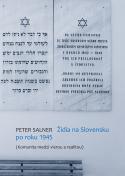Jews in Slovakia After the Year 1945: A Community Between Belief and Reality

- SALNER, Peter. Židia na Slovensku po roku 1945: Komunita medzi vierou a realitou [Jews in Slovakia After the Year 1945: A Community Between Belief and Reality]. Bratislava: Institute of Ethnology SAS, VEDA, 2016. 215 pp. Ethnological Studies no. 24. ISBN 978-80-224-1510.
The publication reveals new and intriguing information on Jewish religious communities in Slovakia after WW2. The author based his research on previously unpublished data from the archives of the Central Association of the Jewish Religious Communities in Slovakia, which provide a unique source of information about its internal organisation and functioning. These data also explain the effort of some Slovak municipalities to preserve Jewish cultural heritage and way of life. Ultimately, as an insider, the author also gives his own personal insight into the life of the Slovak Jewish community.
During the Communist period, Jewish topics were a taboo. Therefore, research on the Holocaust and on the state of the community during the era of the Communist power was not launched before 1989. The exploration of the archives of the Jewish organisations combined with qualitative ethnological methods (oral history method, interviews, observation) allowed for an original insight into the Jewish community. It uncovered ideological tensions and an ambivalent attitude to the Communist regime. The research also confirmed that there are certain specificities compared to the neighbouring post-Communist countries. The survivors coped with existential dilemmas: whether to stay in Slovakia, or to emigrate; whether to live according to the Jewish traditions, or to adapt to the new political situation. An important role in these processes was played by the Central Association of Jewish Religious Communities. The material focuses on Slovakia, but also reaches beyond its borders. The presented findings and conclusions illustrate the local specificities, yet also represent an important background for a comparison with the situation in the neighbouring (post-)Communist countries (Czechia, Hungary, Poland, Ukraine).